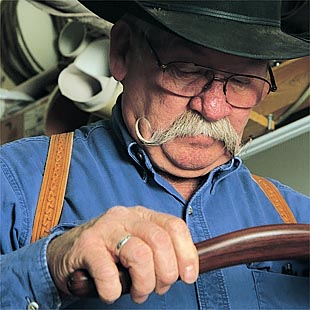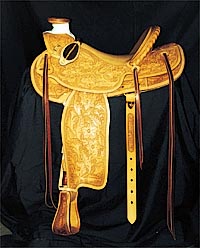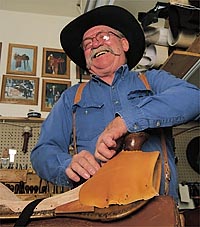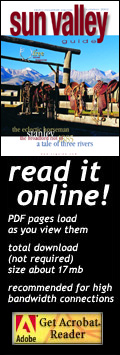| click here for the |
| front page |
| features |
| stanley, idaho |
| bronc riding |
| broadford riot 1885 |
| fighting fires |
| arts |
| three jewelers |
| custom saddles |
| living |
| kitchen design |
| pilates |
| recreation |
| white water fun |
| sporting clays |
| names of the peaks |
| summer trails |
| summer a to z |
| dining |
| seafood in the mtns |
| calendar |
| summer 2002 |
| listings |
| galleries |
| outfitters & guides |
| fitness |
| tennis |
| golf |
| property mgmnt. |
| lodging |
| dining |
| maps |
| ketchum+sun valley |
| summer trails |
| KART bus map |
| the guide |
| last winter |
| advertising |
| about us |
| copyright |
| Copyright
© 2002 Express Publishing Inc. All Rights reserved. Reproduction in whole or in part in any form or medium without express written permission of Express Publishing Inc. is strictly prohibited. |
| Produced
& Maintained by Express Publishing, Box 1013, Ketchum, ID 83340-1013 208.726.0719 Voice 208.726.2329 Fax info@svguide.com |
| The Sun Valley Guide is distributed free twice yearly to residents and guests throughout the Sun Valley, Idaho resort area communities. Subscribers to the Idaho Mountain Express will receive the Sun Valley Guide inserted into the paid edition of the newspaper. |


A Different Kind of Heirloom
By Greg Moore
In the days when Idaho cowboys earned a few dollars a week and spent most nights under the stars, practical concerns dictated their choice of gear.
Then ranching became more mechanized, life grew a little softer, and cowboys could afford to allow vanity to sway their decisions. More than on anything else, vanity was expressed in their choice of a saddle.
According to the Idaho Historical Society, the 1870 census counted only five saddle makers in Idaho. By 1880, there were 10. But following World War II came an explosion in Idaho saddle makers specializing in fancy, custom work.
“We don’t ride that hard anymore, so a lot of the saddles turn into family heirlooms,” said Jim Gill, a Bellevue saddle maker who has built more than 100 saddles for customers in Idaho and surrounding states.
Gill works his craft the old-fashioned way, investing 70 to 80 hours in building a basic saddle. A really fancy one can take twice that. He charges from $2,100 to $3,000 for his creations.
 Gill, 60, grew up in Fairfield, Idaho, following in the footsteps of his great-grandparents, who homesteaded there. He worked on several area ranches throughout his high school years, and took up leatherwork to occupy himself during the long winters. After working decades as a full-time cowboy in southern Idaho, he decided to get back into saddle making 12 years ago and later opened a shop.
Gill, 60, grew up in Fairfield, Idaho, following in the footsteps of his great-grandparents, who homesteaded there. He worked on several area ranches throughout his high school years, and took up leatherwork to occupy himself during the long winters. After working decades as a full-time cowboy in southern Idaho, he decided to get back into saddle making 12 years ago and later opened a shop.
The aromatic smell of tanned leather pervades his small shop off Bellevue’s Main Street. Gill has two big sewing machines and a workbench with a granite slab that provides a hard surface for stamping designs into the leather. He uses about 200 steel stamps with heads ranging from just a point to about an inch across to create the swirling, flowered tooling that decorates his saddles.
The craft of saddle making follows a tradition that probably began in central Asia in the third century B.C. The Western-style saddles most people are familiar with evolved from those used by Hernan Cortes’ men when they invaded Mexico in 1519 and brought horses to the American mainland. When the Mexican ranchers expanded stock-raising operations north into Texas and California, they continued to modify their saddles to accommodate the needs of calf ropers. As ranching spread throughout the western United States, saddle making developed distinct geographical styles.
“The old guys could look at somebody’s saddle and say, ‘What part of Montana do you come from?’” Gill said.
A particularly fancy style of gear and clothing, known as the “buckaroo” style, spread from California into Oregon, Nevada and southeastern Idaho.
Regional styles have since blended, though Gill said there still exists a California style of tooling that appears as interconnected swirls, and a Texas style that emphasizes big flowers and designs that cover most of the saddle.
Tooling is the finishing touch of the saddle maker, who begins with the selection of the tree, leather, various seat styles, skirting and rigging.
Saddles are built by forming leather over a wood or fiberglass tree that acts as its skeleton. Gill said he fits a custom saddle both to the rider and to the breed of horse.
 After settling on the size and style of saddle, he wets the chosen piece of leather and stretches it over the tree. He uses a yoke-shaped piece of hard cocobolo wood, about a foot long, to further stretch the leather and smooth out wrinkles. He tacks it down and lets it dry for about five days. When all the pieces are in place, he sews them together.
After settling on the size and style of saddle, he wets the chosen piece of leather and stretches it over the tree. He uses a yoke-shaped piece of hard cocobolo wood, about a foot long, to further stretch the leather and smooth out wrinkles. He tacks it down and lets it dry for about five days. When all the pieces are in place, he sews them together.
Then the tooling begins. To add decorative patterns, Gill first rewets the leather.
“You’ve really got to pay attention to the water content of your piece. If it’s too wet, it gets mushy and there’s no definition to your design.”
Gill traces the floral shapes with a pattern. Then he uses a cutting tool to incise the outline of the flowers and bevels the edges to accentuate them. He adds details, such as stamens and even little bits of pollen, and stamps down the background.
Gill’s favorite floral designs mimic daisies, geraniums and poppies. He said he hopes his style is distinctive enough that, after he’s gone and his saddles are still around, they are recognizable as his work.
“Everything’s got a line to it, and that’s what you strive for. When you can stand back and look at it and see that it’s all there, it feels good.” •










